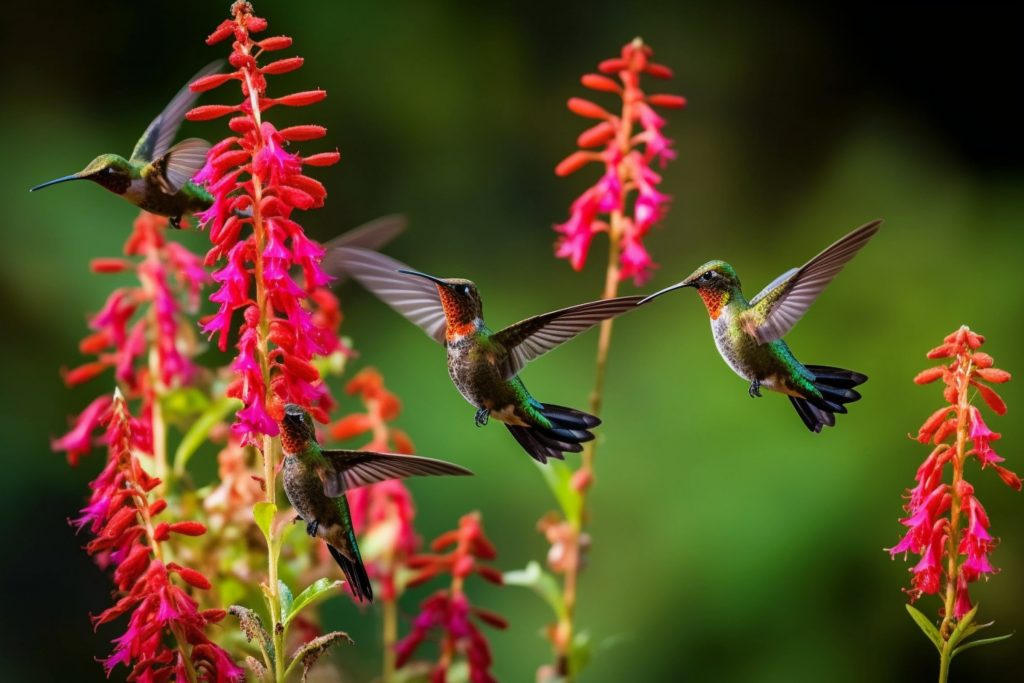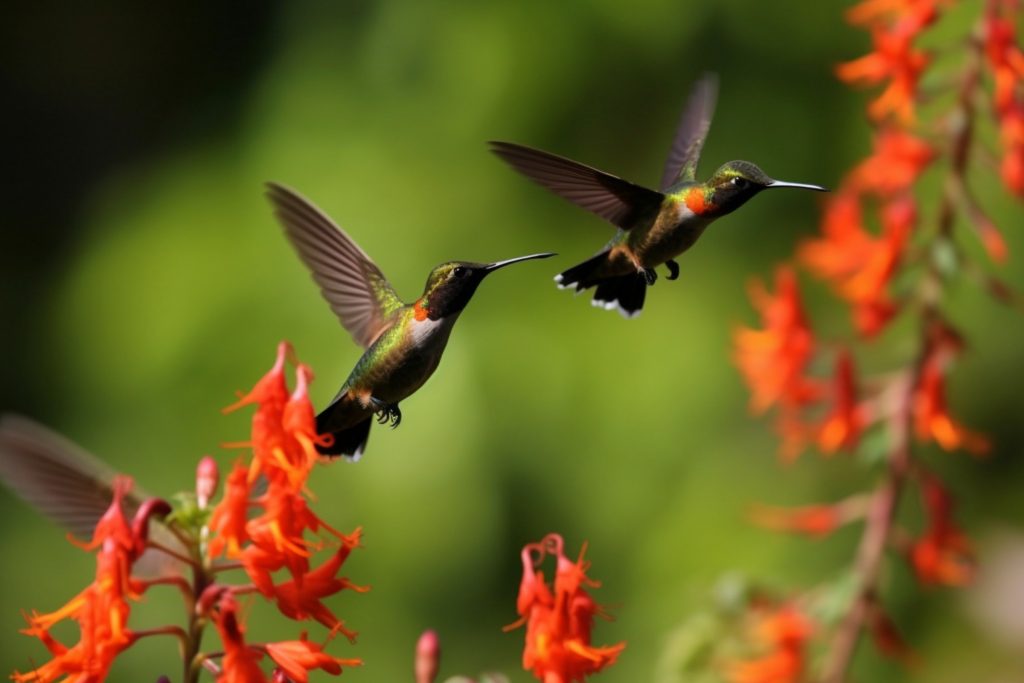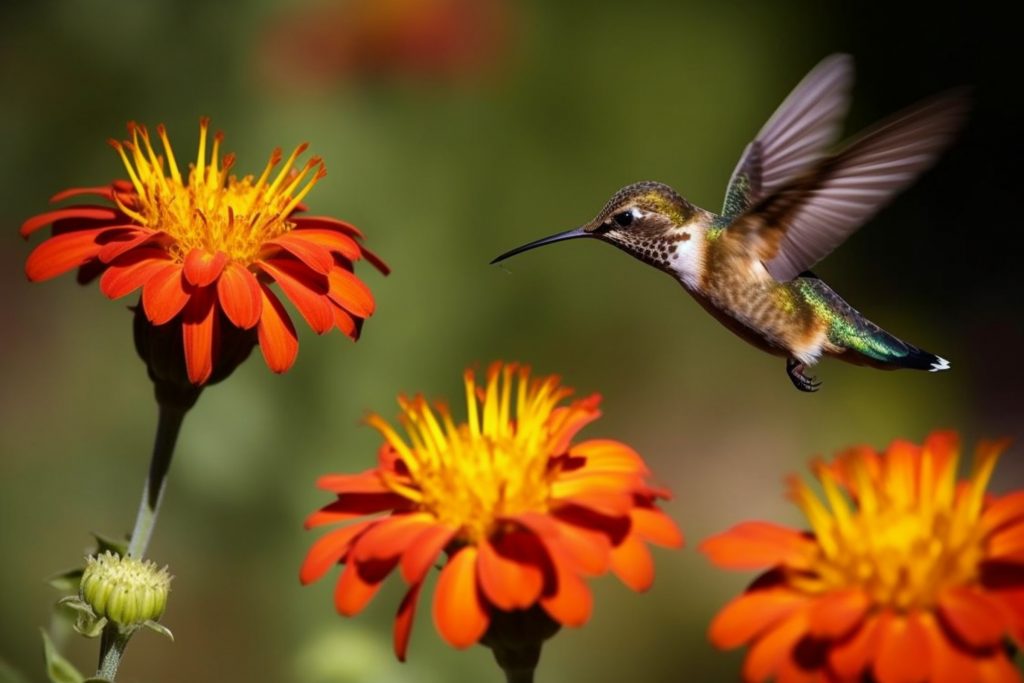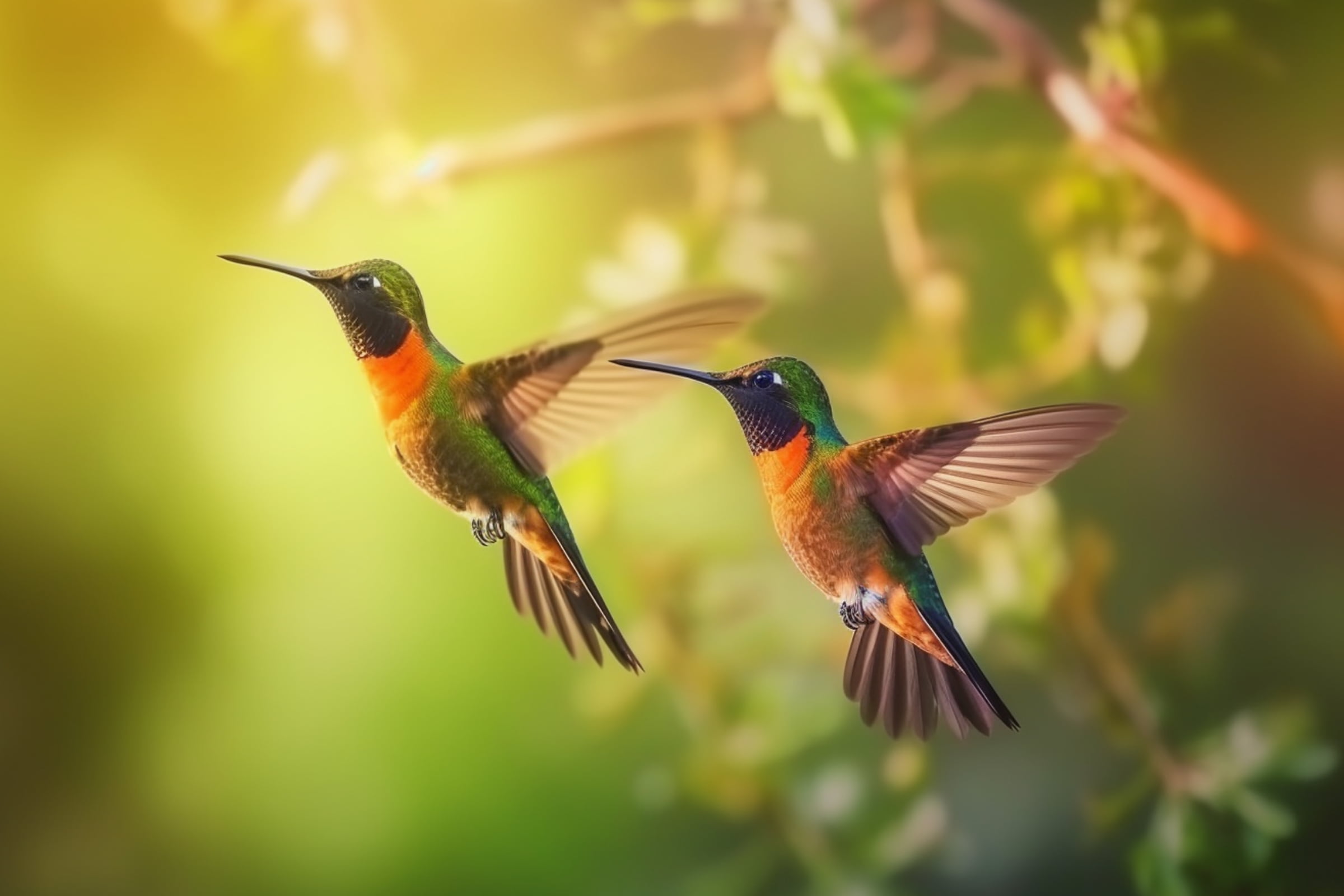No, hummingbirds are not native to Europe. They are indigenous to the Americas, with over 300 species found in diverse habitats across North, Central, and South America.
In Europe, you can find similar creatures that share some characteristics with hummingbirds. One such creature is the Hummingbird Hawk-Moth, which hovers while feeding on nectar from flowers, much like a hummingbird.
Additionally, the Sunbird, found in parts of Africa, Asia, and occasionally southern Europe, also shares similar feeding behaviours and vibrant colours.

The Magic of Hummingbirds
Hummingbirds are the smallest birds on Earth. They have beautiful colours and can fly in amazing ways. They can fly forwards, backwards, and even upside down. With their fast wing beats, they can hover in one spot and fly up to 34 miles per hour. These special skills make them interesting to scientists and bird lovers.
Hummingbirds in Europe: A Rarity
Natural Occurrence
Hummingbirds live in the Americas, with over 300 species found from the Arctic to the tropical rainforests of Central and South America. But you won’t find them naturally in Europe because they evolved and adapted to live in the Americas.
No Hummingbirds in Europe
Despite their fascinating characteristics, hummingbirds are not found in Europe at all. They do not live in the wild, nor are they kept in zoos, aviaries, or as pets. The climates and environments in Europe are not suitable for these birds, and their presence is limited to the Americas.
Exploring the Native Habitats of Hummingbirds
Distribution in the Americas
- North America: In the US and Canada, hummingbirds live in many places, from mountains to deserts. The Rufous hummingbird is common and travels over 3,000 miles each year.
- Central America: This area has many types of hummingbirds. The bee hummingbird, the smallest bird in the world, lives in Cuba.
- South America: South America has the most hummingbird species, like the Giant Hummingbird found in the Andes mountains.

Species Diversity and Examples
There are over 300 species of hummingbirds, each with different colours, sizes, and roles in nature. Some well-known species are the green-backed firecrown, the blue-throated hummingbird, and the broad-tailed hummingbird.
Ecological Roles and Importance
Hummingbirds are important pollinators for many plants. Their long bills and special tongues help them drink nectar from flowers and move pollen from one flower to another. This helps both the birds and the plants.
Observing Hummingbirds
Since you can’t see hummingbirds in Europe, the best way to observe them is by visiting their natural habitats in the Americas. Plan a trip to North, Central, or South America to see these amazing birds in the wild. This way, you’ll appreciate their beauty and importance in nature and help protect their habitats.
Final Thought
To wrap it up, hummingbirds aren’t native to Europe, so you won’t find them in zoos or as pets in Europe. If you want to see these amazing birds, you’ll need to visit the Americas where they live.
Watching them in their natural habitats will help you appreciate how special they are and understand their important role in nature.
Always remember to respect these birds and keep a safe distance. This way, we can ensure that future generations can also enjoy the wonder of hummingbirds and help protect their habitats.

FAQs – Are there Hummingbirds in Europe?
Q: Are there hummingbirds native to Europe?
A: No, hummingbirds are native to the Americas and are not naturally found in Europe.
Q: Where can hummingbirds be found in their natural habitat?
A: Hummingbirds can be found in North, Central, and South America in diverse habitats ranging from the Arctic tundra to tropical rainforests.
Q: How many species of hummingbirds are there?
A: There are over 300 species of hummingbirds known to exist.
Q: What is the primary food source for hummingbirds?
A: Hummingbirds primarily feed on nectar from flowers, which provides them with the energy they need for their high metabolism.
Q: Are there any hummingbird-like creatures in Europe?
A: Yes, the Hummingbird Hawk-moth is an insect that resembles a hummingbird and is found in Europe, but it is not a bird.
Q: What role do hummingbirds play in their ecosystem?
A: Hummingbirds are essential pollinators for many flowering plants, transferring pollen from flower to flower as they feed on nectar.
Q: Can hummingbirds be kept as pets?
A: Some bird lovers may keep hummingbirds as pets or breed them in captivity, but there are ethical implications and challenges in providing a suitable environment for these delicate creatures.
Q: What is the world’s smallest bird species?
A: The bee hummingbird, found exclusively in Cuba, is the smallest bird species in the world.
Q: What is the largest hummingbird species?
A: The Giant Hummingbird (Patagona gigas) is the largest hummingbird species and can be found in the Andean highlands of South America.
Q: Which hummingbird species is widespread in North America?
A: The Rufous hummingbird is a widespread species in North America, known for its long annual migration of over 3,000 miles.
Q: Do hummingbirds have any close relatives in the fossil record?
A: Fossil hummingbirds have been discovered, providing insights into the evolutionary history of these birds and their ancient relatives.
Q: What is the green-backed firecrown hummingbird?
A: The green-backed firecrown hummingbird is a species known for its stunning iridescent colors and is native to South America.
Q: How fast can a hummingbird’s heart rate reach?
A: A hummingbird’s heart rate can reach over 1,200 beats per minute during flight.
Q: How do hummingbirds maintain their body temperature?
A: Hummingbirds regulate their body temperature through a combination of their rapid metabolism, specialized feathers, and behaviours such as torpor during cold nights.
Q: Are there any legal restrictions on keeping hummingbirds?
A: Depending on the country, there may be restrictions or regulations on keeping hummingbirds in captivity, particularly for species protected under international conservation agreements.
Q: What is the blue-throated hummingbird?
A: The blue-throated hummingbird is a species known for its striking blue throat patch and is native to North and Central America.
Q: How do hummingbirds adapt to different flower colours and shapes?
A: Hummingbirds have evolved specialized bills and tongues that allow them to extract nectar from a wide variety of flower shapes and sizes.
Q: Do hummingbirds only feed on nectar?
A: Although nectar is their primary food source, hummingbirds also consume insects and spiders for protein.
Q: How can we help protect and conserve hummingbird species and their habitats?
A: By supporting organizations like the American Bird Conservancy, promoting habitat conservation, and observing birds responsibly, we can help protect and conserve hummingbird species and their habitats for future generations.
Q: What is a broad-tailed hummingbird?
A: The broad-tailed hummingbird is a species native to North and Central America, characterized by its iridescent green colour and distinctive trilling sound made by its wings during flight.
Q: How do hummingbird eyes function in their daily lives?
A: Hummingbird eyes are well-adapted for their high-speed lifestyles, providing excellent vision and the ability to detect rapid movements, which helps them navigate their environment and locate food sources.
Q: Can hummingbirds hover in mid-air?
A: Yes, hummingbirds are the only bird species capable of true hovering, allowing them to feed on nectar from flowers without landing.
Q: What is the significance of hummingbird talismans in some cultures?
A: In various cultures, hummingbirds have been seen as symbols of love, happiness, and energy, leading to their use as talismans or amulets for protection and good fortune.
Q: How has the study of hummingbirds contributed to scientific knowledge?
A: The unique flight capabilities of hummingbirds have inspired research in aerodynamics, biomechanics, and energy efficiency, providing valuable insights into the interface of hummingbird flight and engineering applications.
Q: How can we attract hummingbirds to our gardens in the Americas?
A: Planting a variety of native, nectar-rich flowers, providing clean water sources, and installing nectar feeders can help attract hummingbirds to gardens in their native range.
Q: What is the average breathing rate for hummingbirds?
A: A hummingbird’s breathing rate can range from 250 to 300 times per minute, depending on the species and activity level.
Q: Can hummingbirds recognize individual humans?
A: Some studies suggest that hummingbirds can indeed recognize individual humans, particularly those who regularly provide food or interact with them in a non-threatening manner.
Q: How can I learn more about hummingbirds and their conservation?
A: To learn more about hummingbirds, consider joining a local birdwatching group, attending lectures, or reading publications by organizations such as the American Bird Conservancy and the Journal of Avian Biology.
Q: How have bird hunters impacted hummingbird populations in the past?
A: In the past, bird hunters targeted hummingbirds for their beautiful plumage, which led to population declines for some species. Nowadays, conservation efforts and regulations help protect hummingbirds from excessive hunting.
Q: What are some examples of hummingbird-pollinated flowers?
A: Hummingbird-pollinated flowers include trumpet-shaped blooms, such as trumpet vine, fuchsia, and coral honeysuckle, which provide easy access to nectar for these specialized feeders.
Q: How does a hummingbird’s body weight affect its energy needs?
A: Due to their small body weight, hummingbirds have a high metabolism, requiring them to consume large amounts of nectar to maintain their energy levels and support their rapid flight.
Q: What are some distinguishing features of American hummingbirds?
A: American hummingbirds are known for their iridescent plumage, ability to hover, and their role as key pollinators for many native plant species in the Americas.
Q: What insights do hummingbird fossils provide about ancient hummingbirds and their evolutionary history?
A: Hummingbird fossils offer valuable information about the physical characteristics, geographical distribution, and ecological relationships of ancient hummingbirds, shedding light on their evolutionary history and adaptation to diverse habitats.
Q: How do native species of plants benefit from hummingbirds as pollinators?
A: Native plant species that rely on hummingbirds for pollination benefit from increased genetic diversity, seed production, and overall plant health as hummingbirds transfer pollen from flower to flower while feeding on nectar.
Q: How does the diversity of living species of hummingbirds contribute to their ecological success?
A: The diversity of living species of hummingbirds allows them to occupy various niches within their ecosystems, utilizing different food sources and habitat types, which contributes to their ecological success and resilience.
Q: What can we learn from studying the evolutionary history of hummingbirds?
A: Studying the evolutionary history of hummingbirds can provide insights into the development of their unique adaptations, such as hovering flight and specialized feeding structures, as well as their relationships with other bird species and their role in shaping plant communities.
References:
- Hummingbird (Wikipedia).
- Europe (Wikipedia)
- Greenewalt, C. H. (1960). Hummingbirds. New York: Doubleday. Google Scholar.
